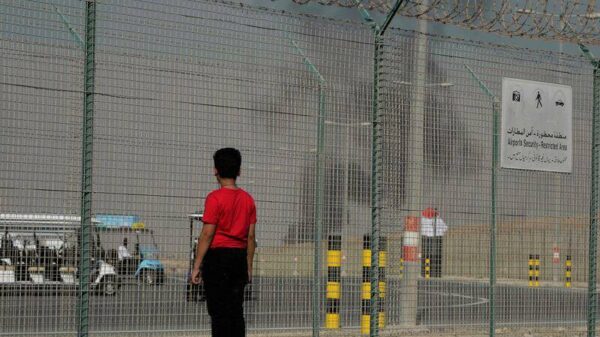Researchers at the New Jersey Institute of Technology (NJIT) have meticulously documented the effects of a series of intense solar flares on Earth’s ionosphere. From November 9 to 14, 2025, a cluster of X-class flares, culminating in an X5.1 event, caused significant disturbances in the upper atmosphere. These flares not only produced stunning auroras visible across a broad area, including northern Europe and as far south as Florida, but also triggered strong radio blackouts over parts of Africa and Europe.
At the heart of this research is NJIT’s Center for Solar-Terrestrial Research (CSTR), where scientists deployed a new network of radio telescopes to study the impacts of solar activity. The flares released from a single active region, designated AR4274, were notable for their intensity and frequency. Notably, four X-class flares occurred within just a few days — an unusual phenomenon.
Bin Chen, a professor of physics at NJIT and director of the Expanded Owens Valley Solar Array (EOVSA), highlighted the significance of the findings, stating, “It’s somewhat unusual to see four X-class flares in just a few days from the same region. What really stood out were the ripple effects right here on Earth.”
While the flares were not visible from NJIT’s Big Bear Solar Observatory, the effects were captured in real-time by radio telescopes at the Owens Valley site in California. The EOVSA and the newly operational Long Wavelength Array (OVRO-LWA) tracked atmospheric changes across various radio frequencies. Chen noted that the data revealed chaotic patterns in radio bursts, indicating a disturbed ionosphere.
The impact of these solar events was substantial. The NOAA classified the resultant geomagnetic storm as G4 on its five-point scale, indicating a severe level of disturbance. Lindsay Goodwin, an assistant professor of physics and ionosphere expert at NJIT, explained, “The Dst index, which measures the compression of Earth’s magnetic field by solar wind, plunged from about –40 nT to nearly –250 nT in just a few hours. That’s a huge shock to our planet’s magnetic defenses.”
The influx of charged particles into the atmosphere generated auroras that exceeded their typical range, delighting observers in regions that seldom experience such phenomena. Goodwin remarked, “My aurora chat group was exploding with images from places that almost never see northern lights.”
This incident underscores the capabilities of NJIT’s radio observatories, as OVRO-LWA has recently commenced full operations dedicated to solar research. Supported by a $4.2 million award from the National Science Foundation, these facilities operate collaboratively as the Owens Valley Solar Arrays (OVSA). Chen emphasized the importance of this combined dataset, stating, “Together, they let us follow space-weather effects from their origin in the solar corona all the way to their impact on Earth’s upper atmosphere.”
In a significant advancement, Goodwin’s team, assisted by NJIT undergraduate Jeremy McLynch, deployed a high-precision GPS receiver beside the OVRO-LWA, affectionately named FLUMPH. This device captures disruptions to satellite-navigation signals during solar storms, allowing researchers to analyze the effects of solar activity on communication technologies.
“Plasma irregularities caused by solar and geomagnetic activity disrupt radio and GPS communication,” Goodwin explained. “Pairing GPS measurements with the LWA data lets us see both sides of the story—how the Sun shakes the ionosphere, and how that affects the technologies we rely on daily.”
As solar activity approaches its peak in the current 11-year cycle, both Chen and Goodwin indicate that similar storms may be on the horizon. Goodwin commented on the ongoing analysis of the storm’s implications, noting, “Scientists are only beginning to understand the full effects of this storm. Historically, extreme solar and geomagnetic events can disrupt power grids, interfere with radio communications, and threaten the safety and operation of satellites.”
The recent solar flares serve as a potent reminder of the interconnectedness of Earth’s systems with cosmic events. Understanding these phenomena is crucial as society increasingly depends on technology reliant on space conditions. As the Sun’s activity eventually diminishes, researchers anticipate a return of similar events in approximately 11 years, emphasizing the importance of continued study in this field.




























































